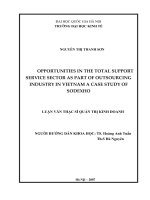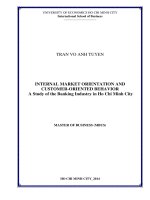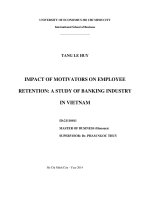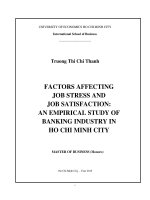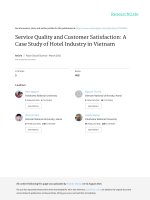Impact of motivatiors on employee retention a study of banking industry in vietnam
Bạn đang xem bản rút gọn của tài liệu. Xem và tải ngay bản đầy đủ của tài liệu tại đây (1.38 MB, 69 trang )
UNIVERSITY OF ECONOMICS HO CHI MINH CITY
International School of Business
------------------------------
TANG LE HUY
IMPACT OF MOTIVATORS ON EMPLOYEE
RETENTION: A STUDY OF BANKING INDUSTRY
IN VIETNAM
ID:21110011
MASTER OF BUSINESS (Honours)
SUPERVISOR: Dr. PHAM NGOC THUY
Ho Chi Minh City - Year 2014
Acknowledgement
Firstly, I would like to express my appreciation to my research supervisor, Dr. Pham Ngoc Thuy
for her support, suggesting, guidance during time of my dissertation.
Secondly, I would like to express my gratitude to ISB committee thoroughly guidance, support to
every student in each steps of this study.
Thirdly, I would warmly thank my family, who has continued to be a source of inspiration and
encouragement throughout this program, especially my parents, and my wife who give a motivator
for me to accomplish the MBA degree.
Last, ISB staff helped, supported with their best for convenience of MBUS 2. I am greatly
appreciated for their contribution to my present result.
Tang Le Huy
February 2014
I
ABSTRACT
Employees retaining is very important for surviving of any organization. The study identifies and
measures the impact level of motivator factors on employee retention in banking industry in
Vietnam. Data was collected from 228 persons, who work in three commercial banks in Binh
Duong province. A likert-scale questionnaire was used to detect motivated factor and employee‘s
retention. The measurement scales were refined and tested unidimentionality, reliability and
validity by Cronbach‘s alpha and exploratory factor analysis. Multiple regression analysis was
used to analyze the data of the study. Research results suggested that Growth, Advancement,
Recognition, Responsibility, and Achievement have positive impacts on employee retention in
banking industry.
Key words: motivated factors, employee‘s retention.
II
TABLE OF CONTENT
LIST OF TABLES .................................................................................................................................. VI
LIST OF FIGURES ................................................................................................................................ VI
CHAPTER 1: INTRODUCTION ................................................................................................ 1
1.1
Background ................................................................................................................................... 1
1.2
Problem statement ........................................................................................................................ 2
1.3
Research Objectives ..................................................................................................................... 4
1.4
Research scope ............................................................................................................................. 4
1.5
Thesis structure ............................................................................................................................. 4
CHAPTER 2: LITERATURE REVIEW ................................................................................... 5
2.1 Predictors of employee retention ........................................................................................................ 5
2.2
Motivators of Employee retention ................................................................................................ 9
2.2.1.
Advancement ........................................................................................................................ 9
2.2.2.
Responsibility ..................................................................................................................... 10
2.2.3.
Recognition ......................................................................................................................... 10
2.2.4.
Achievement ....................................................................................................................... 11
2.2.5.
Growth ................................................................................................................................ 11
2.3 Model and Hypothesis ...................................................................................................................... 12
2.4 Chapter summary .............................................................................................................................. 13
CHAPTER 3: RESEARCH METHODOLOGY ..................................................................... 14
3.1 Research design ................................................................................................................................ 14
3.2. Research methodology ..................................................................................................................... 15
3.2.1. Sampling : ................................................................................................................................. 15
3.2.2. Method of analysis .................................................................................................................... 16
3.3. Measuring instrument ...................................................................................................................... 17
3.3.1. Minesota satisfaction Questionnaire (MSQ) ............................................................................. 17
III
3.3.2. Employee retention ................................................................................................................... 18
3.4. Chapter summary ............................................................................................................................. 19
CHAPTER 4 : DATA ANALYSIS AND FINDINGS .............................................................. 20
4.1 Sample characteristics ....................................................................................................................... 20
4.1.1. Gender: ...................................................................................................................................... 20
4.1.2. Age: ........................................................................................................................................... 20
4.1.3. Working position: ..................................................................................................................... 21
4.2. Assessment of measurement scales .................................................................................................. 21
4.2.1. Testing reliability of scales ....................................................................................................... 22
4.2.2. Exploratory Factor Analysis (EFA) .......................................................................................... 24
4.3 Testing model and hypotheses ......................................................................................................... 26
4.3.1 Testing model ............................................................................................................................. 26
4.3.2 Testing hypotheses ...................................................................................................................... 28
4.3.3 Description of statistics of overall employee retention .............................................................. 31
4.4 Discussions ........................................................................................................................................ 31
4.4.1 Levels of importance of motivators ............................................................................................ 31
4.4.2 Differentiation among three groups of working duration .......................................................... 33
4.4.3 Comparing the level of retention between managers and staff .................................................. 35
4.6. Chapter summary ............................................................................................................................. 37
CHAPTER 5 : CONCLUSIONS AND RECOMMENDATIONS .......................................... 38
5.1 Conclusion ........................................................................................................................................ 38
5.2 Managerial implication and Recommendation ................................................................................. 39
5.3 Limitation and further research direction.......................................................................................... 42
IV
REFERENCES ............................................................................................................................ 43
APPENDIX 1 : SURVEY QUESTIONNAIRE ........................................................................... 47
APPENDIX 2 : CRONBACH'S ALPHA TEST RESULTS ........................................................ 51
APPENDID 3: EXPLORATORY FACTOR ANALYSIS TEST RESULTS .............................. 55
APPENDID 4: RESULTS OF REGRESSION ANALYSIS ....................................................... 58
V
LIST OF TABLES
Table 1: The turnover rate of Vietinbank in 2012-2013 ............................................................................... 3
Table 2: Maslow vs Hertzberg - Comparative Analysis: .............................................................................. 6
Table 3 : The result of job enrichment program by Herzberg 1976.............................................................. 8
Table 6 : Descriptive Statistics by gender ................................................................................................... 20
Table 7: Descriptive Statistics by age. ........................................................................................................ 21
Table 8: Descriptive Statistics by working position. .................................................................................. 21
Table 9: Cronbach's Alpha test results. ....................................................................................................... 22
Table 10: KMO and Bartlett's Test. ............................................................................................................ 24
Table 11: Total Variance Explained. .......................................................................................................... 24
Table 12: Rotated Component Matrix(a). ................................................................................................... 24
Table 13: Result of EFA Retention. ............................................................................................................ 25
Table 14: Summary results of testing scales ............................................................................................... 26
Table 15: Correlations (a). .......................................................................................................................... 27
Table 16: Model Summary (b). ................................................................................................................... 27
Table 17: ANOVA(b). ................................................................................................................................ 27
Table 18: Coefficients(a). ........................................................................................................................... 28
Table 19: Regression coefficients. .............................................................................................................. 29
Table 20: Descriptive statistics for the dimensions of employee retention................................................. 31
Table 21: Levels of importance factors on employee retention. ................................................................. 31
Table 22: Descriptive statistics for employee‘s working time. ................................................................... 33
Table 23: Model Summary(b) of three groups employee's working time .................................................. 34
Table 24: Coefficients of three groups employee's working time.............................................................. 34
Table 25: Retention of employees. ............................................................................................................. 36
Table 26: Retention of managers, supervisors ........................................................................................... 36
VI
LIST OF FIGURES
Figure 1: Research model ........................................................................................................................... 12
Figure 2: Research procedure. .................................................................................................................... 14
Figure 3: Regression coefficients of model ................................................................................................ 30
VII
CHAPTER 1: INTRODUCTION
This chapter is an introduction and to provide background information of the present study and
its objectives and purpose. It includes five sections. The first section is background of the
research, the second is the problem statement, the third is the research objective, the fourth is the
scope of study and the final section is the structure of study.
1.1 Background
The retention of employees is very important for the development and the
accomplishment of an organization‘s goals and objectives. Retention of employees can be a vital
source of competitive advantage for any organization. Today, changes in technology, global
economics crisis, are directly affecting the relationships between employee and employer.
Outstanding employees may leave an organization because they become dissatisfied, underpaid
or unmotivated (Coff, 1996). Besides these problems, asymmetric information or lack of
information about the employees‘ performance may make a challenge for organization to retain
productive employees. Without adequate employees‘ performances, an organization may not be
able to distinguish productive workers from non-productive ones.
Insufficient information about employees‘ performance may result in adverse selection
by them (Grossman & Hart, 1986). The employees who perform better may move to other
organizations for better opportunities. The employees who cannot improve their positions are
more likely to stay. This is a problem when nonproductive and productive workers receiving the
same or nearly the same compensation and package of perks because of management‘s inability
to distinguish talented employees from the rest of the labor force in the organization. The
problem of attempting to keep talented members of the workforce is further complicated
1
because of bounded rationality (Simon, 1976). High turnover rate is the reason for increasing
cost in training and recruitment because the new employees don‘t have experiences and
organization will spend a lot of time and cost on training them. Moreover, high turnover rate has
a negative influence on the emotion of retention people.
1.2 Problem statement
In 2013, Vietnamese government continues their objects: curbing inflation, stabilizing
macro economy. As a result, banking sector has faced with a difficult problem for reaching
their target on credit growth and profit. According to State Bank of Vietnam, total revenue of
banking industry in 2012 is 28.600 billion dong, decreasing 50% compare to 2011 (InfoTV,
2013) and annual report in 2012 of Vietinbank, Vietcombank, Eximbank, Seabank showed that
their employee‘s salary decreased comparing to 2011. Moreover, Nguyen Tri Hieu, expert in
banking finance, who said that ―in 2012, salary of banking sector is average comparing to the
rest sector‖.
Thus, employees in banking sector have been faced with high pressure in work, lacking
time for themselves, their family, and salary is not high, so the turnover rate in this sector is very
high. According to survey of Towers Watson in 2012 (Company provides support services,
human resources management, financial and risk in Vietnam) reported that the turnover rate in
banking sector is highest, 16% comparing to the rest sectors. A result by interviewing the human
resources managers of Vietinbank showed that Vietinbank‘s voluntary turnover rate in 2012 and
the first six month of 2013 is 7.3% in average.
2
Table 1: The turnover rate of Vietinbank in 2012-2013( Source: Human resources
managers of Vietinbank)
Vietinbank’s Branch
Turnover rate of 2012
Turnover rate of first six
month in 2013
Bình Phước
2%
1%
Bắc Sài Gòn
16.3%
16.6%
Hoà Thành
5.9%
6.3%
5%
6.7%
7.3%
7.65%
Bình Dương
Average retention rate
However, in this difficult situation, the banks also want to keep their employees who have a good
skills and experiences in order to reach their business‘s target. There are very necessary to
investigate these factors that influence employee retention rate and find out the valuable human
resources strategies for keeping good employees in banking industry.
Employee‘s retention is considered by the leaders of the banks. They implemented various ways
to increase level of retention such as:
increasing salary, training more skills, offering
opportunities for promotion … However, the turnover rate is still high. What are the motivated
factors and the level relationship that influence the employee‘s retention?
Previous researchers suggested some motivator factors that effect to retention such as: hunger,
thirst, shelter, safety, social, and esteem needs (Maslow, 1954). Achievements, recognition, work
itself, responsibility, advancement, and growth (Herzberg, 1959). What are the factors that have
a relationship with retention in banking industry?
This study is expected to find the key motivator factors that effect to retention in banking
industry and to provide new solutions and evidences for human resource management in order to
reduce the turnover rate in this sector.
3
1.3 Research Objectives
This research aimed at clarifying the impact of motivator factors to the employee retention in the
banking industry in Vietnam with the specific objectives:
To identify the impact of motivation factors (in Herzberg‘s two factor theory) on
employee retention in banking industry in Vietnam.
To measure the impact level of these factors on employee retention in banking industry
in Vietnam.
To examine the differences the impact of motivation factors on employee retention
among groups of working duration, and the level of intention between manager and staff.
1.4 Research scope
Given the limited resources and time, the empirical data for the research were collected from
commercial banks in Binh Duong province. They are Vietinbank, EximBank and Vietcombank.
The respondents are 300 employees from those banks.
1.5 Thesis structure
Chapter 1: Introduction presents the research background, problem statements, research
objectives, and research scope and thesis structure.
Chapter 2: Literature review presents literature review, research model and hypotheses.
Chapter 3: Research methodology illustrates the methodology of this paper.
Chapter 4: Data analysis and findings presents research results based on collected data.
Chapter 5: Discussion, conclusion and recommendations summarizes the research results,
provide the findings and recommendations.
4
CHAPTER 2: LITERATURE REVIEW
This chapter presents the theories which relate to employee retention. In this literature review,
factors effect employee retention will be represented. Then, the model research will be proposed
for this specific study.
2.1 Predictors of employee retention
Employee retention is about developing strategies that reduce the number of people who
leave the organization for avoidable reasons. Organizations need to retain employees with the
required balance of skills and experience to ensure that business can be maintained (Stucberry,
2003). When employees leave their job, the organization will lost the employees who have
knowledge about production, current project, competitor and the loyal customer and client of
organization. There are many factors that affect the employee's reasons for staying with the
organizations, as well as how important those factors are to employees. In order to retain
employees, the organization must understand these factors, which motivate people to perform
their jobs and monitor the job satisfaction of employees.
Cappelli (2000) suggested factors which play important role in employee retention:
career opportunities, work environment, work life balance, Organizational justice, and existing
leave policy and organization image. Cole (2000) founded that employees stay with organization
where they are highly appreciated and work with their full potential and the reasons, which make
the employee remain in their job are: organization reward system, growth and development, pay
package and work life balance.
5
There are some of the more famous theories within this motivation category: Maslows‘
Hierarchy of Needs Theory (1954) , and Herzberg‘s Two-Factor Theory (1959).
Maslow‘s Hierarchy of Needs Theory is one of the most well-known motivational
theories. Abraham Maslow‘s theory identifies five levels of hierarchical needs that every people
attempt to accomplish in their life. The needs start with the physiological (hunger, thirst, shelter)
and then move upward in a pyramid shape through: safety, social, and esteem needs, to the
ultimate need for self-actualization. The peak of pyramid is self-actualization that is defined as
one‘s desire and striving towards maximum personal potential. The pyramid shape to the theory
is intended to show that some needs are more important that others and must be satisfied before
the other needs can serve as motivators (Schermerhorn, 2003).
Herzberg‘s Two-Factor Theory divides motivation and job satisfaction into two groups of
factors: the motivation factors, and hygiene factors. The motivation factors are achievement,
recognition, work itself, responsibility, advancement, and growth. The hygiene factors are
company policy, supervision, relationship with supervision, work conditions, relationship with
peers, salary, personal life, and relationship with subordinates, status, and job security.(Herzberg,
1959).
Table 2: Maslow vs Hertzberg - Comparative Analysis:
Maslow
Meaning
Maslow's theory is based on the concept of
human needs and their satisfaction.
Hertzberg
Hertzberg's theory is based on the use of
motivators which include achievement,
recognition and opportunity for growth.
Basic of the theory
6
Maslow's theory is based on the hierarchy
Hertzberg refers to hygiene factors and
of human needs. He identified five sets of
motivating factors in his theory. Hygiene
human needs and their satisfaction in
factors are dissatisfies while motivating
motivating employees.
factors motivate subordinates. Hierarchical
arrangement of needs is not given.
Nature of the theory
Maslow's theory is rather simple and
Hertzberg's theory is more prescriptive. It
descriptive. The theory is based long
suggests the motivating factors which can be
experience about human needs.
used effectively. This theory is based on
actual information collected by Hertzberg
by
interviewing
200
engineers
and
accountants.
Applicability of the theory
Maslow's theory is most popular and widely
Herzberg's theory is an extension of
cited theory of motivation and has wide
Maslow's
applicability. It is mostly applicable to poor
applicability is narrow. It is applicable to
and developing countries where money is
rich and developed countries where money
still a big motivating factor.
is less important motivating factor.
Descriptive or Prescriptive
Maslow's theory or model is descriptive in
nature.
theory
of
motivation.
Its
Herzberg's theory or model is prescriptive in
nature.
According to Maslow's model, any needs In the dual factor model of Hertzberg,
can act as motivator provided it is not hygiene factors (lower level needs) do not
satisfied or relatively less satisfied.
act as motivators. Only the higher order
needs
(achievement,
recognition,
challenging work) act as motivators.
(Comparative Analysis between Maslow vs Hertzberg (Source: Akrani, 2011)
A result of job enrichment program was initiated at Hill Air Force Base in Utah by Herzberg
which revealed that: The enriched jobs reduce rate of personnel turnover, less overtime and
7
rework, a reduction in man-hours, and material savings. (Herzberg 1976, 1977).
Table 2 : The result of job enrichment program by Herzberg 1976
Reported increase prior to
Reported increase during
Motivation factors
enrichment (%)
enrichment (%)
Overall satisfaction factors
33
76
15
20
Achievement
28
67
Work itself
10
70
Responsibility
15
60
Advancement
23
62
Growth
30
72
Recognition for
achievement
Source: Adapted from Herzberg and Zautra (1976).
Mausner and Snyderman (1999) consider the organization-based motivational variables which
are responsible for employees‘ job satisfaction. Job satisfaction /dissatisfaction have long been
recognized as a predictor of employee retention and turnover. The theory attempts to explain
satisfaction and motivation in organizations by stating that satisfaction and dissatisfaction are
driven by different factors (that is motivation and hygiene factors) respectively. Motivators are
those aspects of the job that make people want to perform and inform their decision to stay or
quit an organization.
Job satisfaction is very important in organization, dissatisfaction often leads to lethargy and
reduced organizational commitment. Lack of job satisfaction is a predictor of quitting a job
(Alexander, Litchtenstein, and Hellmann, 1998). If any employee is not being motivated by the
factors, quitting tendency is observed (Bolarin, 1993).
Moreover, correlation exists among perceived work motivation, job satisfaction and staying
length of employees in the organization corresponds with (Brown and Shepherd, 1997) who
8
reported that motivation improves workers' job satisfaction. Tang and LiPing (1999) reported
that a relationship exists between job satisfaction and employee turnover. Furthermore, Stokes,
Riger and Sullivan's (1995) reported that motivation relates to job satisfaction and even
intention to stay the firm. High job satisfaction creates the high level of motivation among the
employees. And high level of motivation intents to the lower level of turnover (Abraham,
Ando and Hinkle, 1998; Mael and Ashforth, 1995; Ellemers, Spears and Doosje, 1997; WanHuggins, Riordan and Griffeth, 1998).
Base on literature discussion above, there are relationship exists between motivation and
employee retention. However, almost previous studies only focus on hygiene factors such as:
company policy, supervision, relationship with supervision, work conditions, relationship with
peers, salary, personal life, and relationship with subordinates, status, and job security… In
order to identify and measure the impact level of motivator factors in employee retention, this
research
will
use
motivator
factors
(Advancement,
Responsibility,
Recognition,
Achievement, and Growth) of Herzberg‘s theory to answer this problem in banking industry
in Vietnam.
2.2 Motivators of Employee retention
Base on Herzberg‘s theory, there are five main motivators as follows:
2.2.1. Advancement
This refers to the expected or unexpected possibility of promotion. An example of negative
advancement would be if an employee did not receive an expected promotion or demotion.
Oosthuizen (2001) stated in his research that advancement is one of strong motivator factor. The
9
advancement may create the opportunity for personal growth, increased levels of responsibility
and an increase on social standing. Arnolds and Boshoff (2001) suggest that if manager provide
more promotion opportunities, the employee job performance will higher increase. Base on
discussion, there is a strong relationship between advancement and retention, so the hypothesis
is:
H1: There is a positive significant impact of advancement on employee retention.
2.2.2. Responsibility
This involves the degree of freedom an employee has to make their own decisions and
implement their own ideas. The more liberty to take on that responsibility the more inclined the
employee may be to work harder on the project, and be more satisfied with the result. The
responsibility exist when the managers believe in employee‘s decisions and encourage them
implement their innovation (Conger & Kanungo, 1998). The responsibility is one of the
motivator factors for improving effective management because it raises employee‘s confidence
in working (Conger & Kanungo, 1988). Therefore, the hypothesis is:
H2: There is a positive significant impact of responsibility on employee retention.
2.2.3. Recognition
When the employee receives the acknowledgement they deserve for a job well done, the
satisfaction will increase. If the employees work is overlooked or criticized it will have the
opposite effect. The annual survey of Watson Wyatt in USA 2002 finds that recognition is
important for workers because they want organization recognized and appreciated their work.
Some previous studies stated that recognition has a positive impacted on employee‘s retention
10
(Allen, Shore & Griffeth 2003; Bergiel et al. 2009). Therefore, the hypothesis is:
H3: There is a positive significant impact of recognition on employee retention.
2.2.4. Achievement
An example of positive achievement might be if an employee completes a task or project
before the deadline and receives high reviews on the result, the satisfaction the employee
feels would increase. High reviews on the result that refers to the remuneration of the banks
(salary, benefits, and incentive). Employees‘ motivation will enhance by monetary and nonmonetary reward and incentives (Bergiel, Nguyen, Clenney & Taylor 2009; Dockel 2003).
Bergiel (2009) suggested that there is a significant and positive relationship between
compensation and job embeddedness. Thus, hypothesis is:
H4: There is a positive significant impact of achievement on employee retention.
2.2.5. Growth
This motivation factor includes the chance one might have for advancement within the
company. This could also include the opportunity to learn a new skill or trade. When the
possibility/opportunity for growth is lacking or if the employee has reached the peak or glass
ceiling, as it is sometimes referred to, this could have a negative effect on the satisfaction the
employee feels with their job and position.
The sufficient training opportunities to employees and training program should be an
important plan for employee growth and development (Dockel 2003; Kraimer, Seibert,
Wayne, Liden & Bravo 2011). Storey and Sisson (1993) stated that training and promotion is
the way that employers implement their commitment to the staff. Training and promotion can
11
increase level of retention (Frazis et al., 1998; Wetland, 2003). Thus hypothesis is:
H5: There is a positive significant impact of growth on employee retention.
2.3 Model and Hypothesis
According to hypotheses that stated above, the proposed research model was shown below:
Advancement
Responsibility
Employee
Retention
Recognition
Achievement
Growth
Figure 1: Research model
Hypothesis 1: There is a positive significant impact of Advancement on employee retention.
Hypothesis 2: There is a positive significant impact of Responsibility on employee
retention.
Hypothesis 3: There is a positive significant impact of Recognition on employee retention.
Hypothesis 4: There is a positive significant impact of Achievement on employee retention.
Hypothesis 5: There is a positive significant impact of Growth on employee retention.
12
2.4 Chapter summary
The chapter introduced the concept of employee retention and showed the different
motivational theories relating to employee retention. The results of previous researches
have been referred to support the literature. From the literature review, motivator factors
are represented and the model of employee retention is proposed for this study.
13
CHAPTER 3: RESEARCH METHODOLOGY
This chapter reports the methodology that used to test the model and hypotheses that stated in
previous chapter.
3.1 Research design
The research procedure is depicted in Figure 2:
Figure 2: Research procedure.
Problem
Statement
Objectives
Literature review
Research Model and
Hypothesis
Hypotheses
Qualitative research methods
Questionnaire - Quantitative method
Data collection, data analysis and hypothesis
testing
Hypothesis testing
Conclusion and Recommendation
14
3.2. Research methodology
3.2.1. Sampling :
Sample size :
Sample size depends on analytical methods, this study has used Exploratory Factor Analysis
(EFA) which, according to Hoang and Chu (2005) suggested that the number of samples to be 5
times the number changes observed; The study was conducted with 30 observed variables (30
variables x 5 = 150 observations sample), the sample size must be at least 150. Similarly,
according to Hair et al. (1998) cited in Nguyen (2011), refers to observations/items rate is 5:1,
that means a measured variable at least five observed variables. Moreover, Tabachnick & Fidell
(1991) cited in Nguyen (2011), suggested that regression analysis to achieve best results, the
sample size to satisfy the formula:
n ≥ 8k + 50
(3.1)
(n is the sample size and k is the number of independent variables of the model).
This research conducted with sample sizes of about 228 is considered appropriate.
Data collection process :
Sampling method of this study was convenience sampling method; the object is officer
employees in banks in Binh Duong provinces.
The data of this study was obtained from employees in banks in Binh Duong provinces. At the
time the study was undertaken, there were about 300 employees who were working at banks.
Participants in this study are classified as employees, supervisor and head / deputy department.
The response rate is 83% or 250. After filtering, a number of questionnaires were eliminated
due to many missing values. The data were based on 228 questionnaires – the sample. The data
are used for later analysis.
15
3.2.2. Method of analysis
The Statistical Package for the Social Sciences (SPSS) version 20.0 was used for all statistical
calculations. Descriptive and inferential statistics includes: Cronbach alpha, EFA, correlation
and multiple regression analysis. The analysis process is implemented as follow:
Step 1 : Testing the reliability of the scale: The multi-items scale developed above have
to be evaluated for their reliability, unidimensionality and validity. Cronbach alpha is the most
commonly use approach test reliability. Cronbach alpha will be high if the scale is highly
correlative (Hair et al., 1998). Unidimensionality is defined as the existence of one construct
of underlying a set of items (Garver and Mentzer, 1999). Unidimensionality should be test
before doing reliability tests because reliability such as Cronbach alpha does not ensure
unidimensionality but instead assumes it exists (Hair et al., 1998).
Step 2: Using the EFA tests the convergence of variables in the model. In the current
research, the main assessment method is exploratory factor analysis (EFA). There are two basic
methods used for extracting factors in EFA, common factor analysis and principal component
factor analysis.
EFA with principal component, eigenvalue >= 1 and varimax rotation was applied to
6 constructs under investigation (Conway and Huffcutt, 2003). The main purpose of this step is
to see whether the scale for each constructs under investigation is unidimensional or
multidimensional. For a scale to be empirically unidimensional, the factor analysis must result
in only one factor extracted. Moreover, item with low factor loading < 0.40 were eliminated
because they do not converge properly with the latent construct they were designed to measure
(Hair et al., 1998).
16
Step 3: Analysis of linear regression for the intensity of the impact of the independent
variables on the dependent variable. Since then, will examine the appropriateness of the model,
building multiple regression models, testing the hypothesis.
3.3. Measuring instrument
3.3.1. Minesota satisfaction Questionnaire (MSQ)
Responses are scored on a five-point scale ranging from 1 for ―strongly disagree‖, 2 for
―disagree‖, 3 for ―neutral‖, 4 for ―agree‖, and 5 for ―strongly agree‖.
Advancement
Code
Items
Adv01
Adv02
Adv03
Adv04
The opportunities for advancement on this job.
The chances of getting ahead on this job.
The way promotions are given out on this job.
The chances for advancement on this job
Res05
Res06
Res07
Res08
Res09
Items
The chance to be responsible for planning my work.
The chance to make decisions on my own
The chance to to responsible for the work of others
The freedom to use my own judgment.
The responsibility of my job.
Source
Weiss, Dawis, England,
and Lofquiest (1967),
Sungmin Hyun (2009).
Recognition
Code
Rec10
Rec11
Rec12
Rec13
Rec14
Weiss, Dawis, England,
and Lofquiest (1967),
Sungmin Hyun (2009).
Resposibility
Code
Source
Items
The way I am noticed when I do a good job
The way I get full credit for the work I do
The recognition I get for the work I do
The way they usually tell me when I do my job well
The praise I get for doing a good job
Source
Weiss, Dawis, England,
and Lofquiest (1967),
Sungmin Hyun (2009).
Achievement
17
